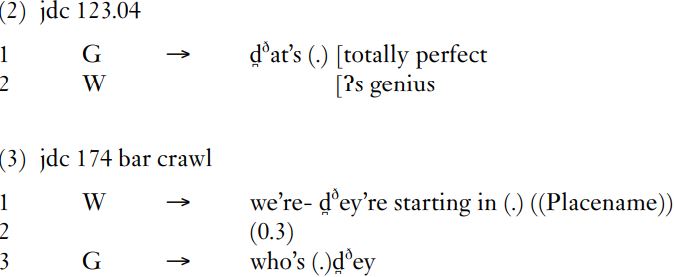


 Grammar
Grammar
 Tenses
Tenses
 Present
Present
 Past
Past
 Future
Future
 Parts Of Speech
Parts Of Speech
 Nouns
Nouns
 Verbs
Verbs
 Adverbs
Adverbs
 Adjectives
Adjectives
 Pronouns
Pronouns
 Pre Position
Pre Position
 Preposition by function
Preposition by function 
 Preposition by construction
Preposition by construction
 Conjunctions
Conjunctions
 Interjections
Interjections
 Grammar Rules
Grammar Rules
 Linguistics
Linguistics
 Semantics
Semantics
 Pragmatics
Pragmatics
 Reading Comprehension
Reading Comprehension|
Read More
Date: 23-7-2022
Date: 2023-06-21
Date: 2023-05-04
|
Plosives can be released into friction which is generated immediately on release. In this case, the two articulators are separated only so far as to generate a stricture of close approximation, causing friction on release. This friction is homorganic with the plosive, i.e. it is made at the same place of articulation. The friction can be long or short in duration.
Combinations of plosive + long fricative release are commonly known as ‘affricates’. English has two clear instances of affricates, [tʃ] and  . These are clear cases because they both pattern phonologically as one unit. They occur both syllable initially and syllable finally. For both, the coronal closure is postalveolar, and the tongue shape is the one required for [ʃ] and
. These are clear cases because they both pattern phonologically as one unit. They occur both syllable initially and syllable finally. For both, the coronal closure is postalveolar, and the tongue shape is the one required for [ʃ] and  . (See the production of fricatives.) More narrowly, then, they can be transcribed as
. (See the production of fricatives.) More narrowly, then, they can be transcribed as  .
.
The release of the plosive portion is immediately into friction. The best way to realize the difference is to take a pair where there is a sequence of [t] + [ʃ] vs. an affricate [tʃ], such as ‘why choose/white shoes’, ‘to buy chews/to bite shoes’. In the cases with affricate [tʃ], the first word ends with an open articulation, and the second begins with an affricate; in cases with [t+ʃ], the first word ends with an alveolar closure and the second starts with a fricative. The closure is longer in the [t + ʃ] sequences than in the [-tʃ-] cases. The tongue shape on release is flatter in the [t + ʃ] sequences, whereas in the [-tʃ-] cases it has the appropriate shape for generating postalveolar friction. The closure is also a little further back for the affricate [tʃ]. These many small details reveal some of the subtle phonetic distinctions that can be made to differentiate what on paper at least look like potentially homophonous sequences.
Other common affricate sequences in English are [t ɹ‑ d ɹ]. [t ɹ‑] occurs syllable initially, e.g. in ‘tree, tram, true’. The plosive part, [t ], involves a postalveolar closure with a tongue shape appropriate for a [ɹ] sound: the tongue is somewhat curled back, the sides make a tight contact with the teeth, and the tongue back is raised. It can be classed as an affricate because the release part, [ɹ‑], involves friction caused by the curling back of the tongue. There may also be a narrow channel down the tongue, causing some degree of whistling on release.
 is the voiced equivalent of
is the voiced equivalent of  . As a voiced sound, it has weaker friction than
. As a voiced sound, it has weaker friction than  .
.
 and
and  are distinguishable from sequences of [t+r] and [d+r] because they only occur syllable initially. If you compare pairs such as ‘a tree’,
are distinguishable from sequences of [t+r] and [d+r] because they only occur syllable initially. If you compare pairs such as ‘a tree’,  vs. ‘at Reeth’,
vs. ‘at Reeth’,  , then you should notice several differences between them (Table 7.2).
, then you should notice several differences between them (Table 7.2).

We turn now to plosives with short periods of friction on release. We will transcribe these with a small superscript symbol for the frication portion.
Initial [ð] can often be pronounced as  , especially when utterance initial. Many function words (which are commonly phrase initial), such as ‘the, this, that, those, they’, start with this sound.
, especially when utterance initial. Many function words (which are commonly phrase initial), such as ‘the, this, that, those, they’, start with this sound.
Below are three examples of  . G speaks a dialect from the West Midlands of England (around Birmingham); W’s variety is from the north west of England.
. G speaks a dialect from the West Midlands of England (around Birmingham); W’s variety is from the north west of England.

Plosives released with short periods of friction are common in English. Most speakers have some degree of frication in their release of the closure for [t], giving a sound which is sometimes transcribed as  . In Edinburgh (Chirrey, in Foulkes and Docherty 1999: 227), fricated releases for word-final plosives are reported, as in
. In Edinburgh (Chirrey, in Foulkes and Docherty 1999: 227), fricated releases for word-final plosives are reported, as in  , ‘take, food’, respectively.
, ‘take, food’, respectively.
|
|
|
|
"عادة ليلية" قد تكون المفتاح للوقاية من الخرف
|
|
|
|
|
|
|
ممتص الصدمات: طريقة عمله وأهميته وأبرز علامات تلفه
|
|
|
|
|
|
|
المجمع العلمي للقرآن الكريم يقيم جلسة حوارية لطلبة جامعة الكوفة
|
|
|